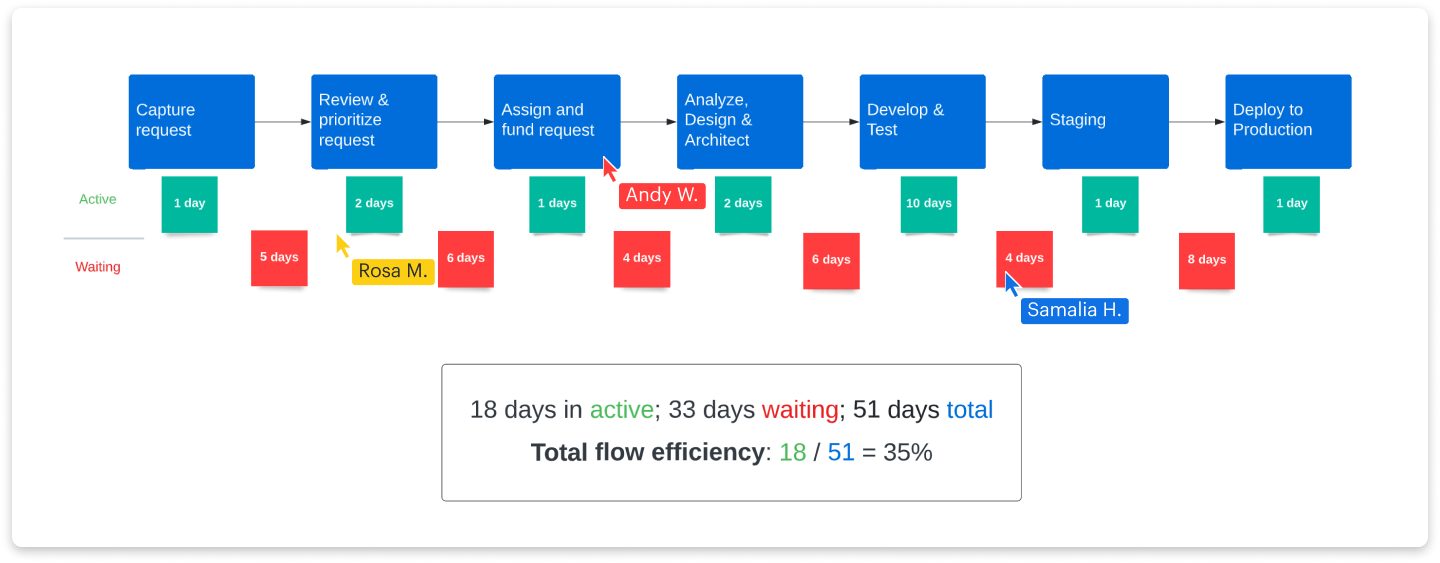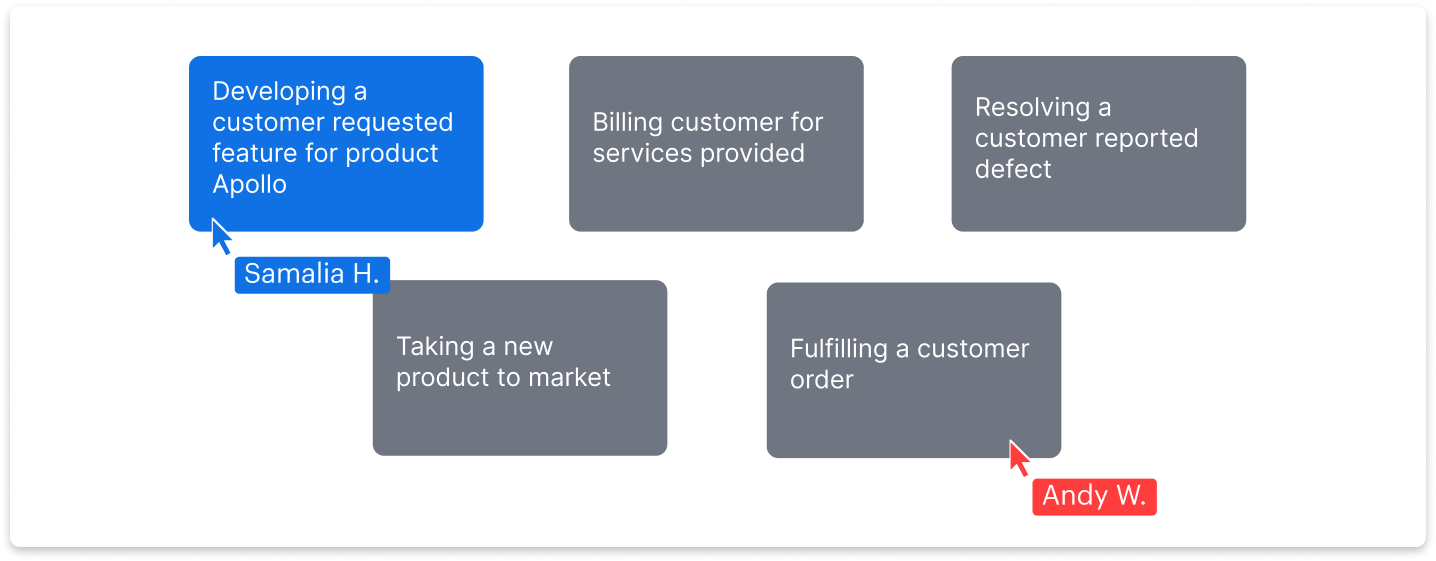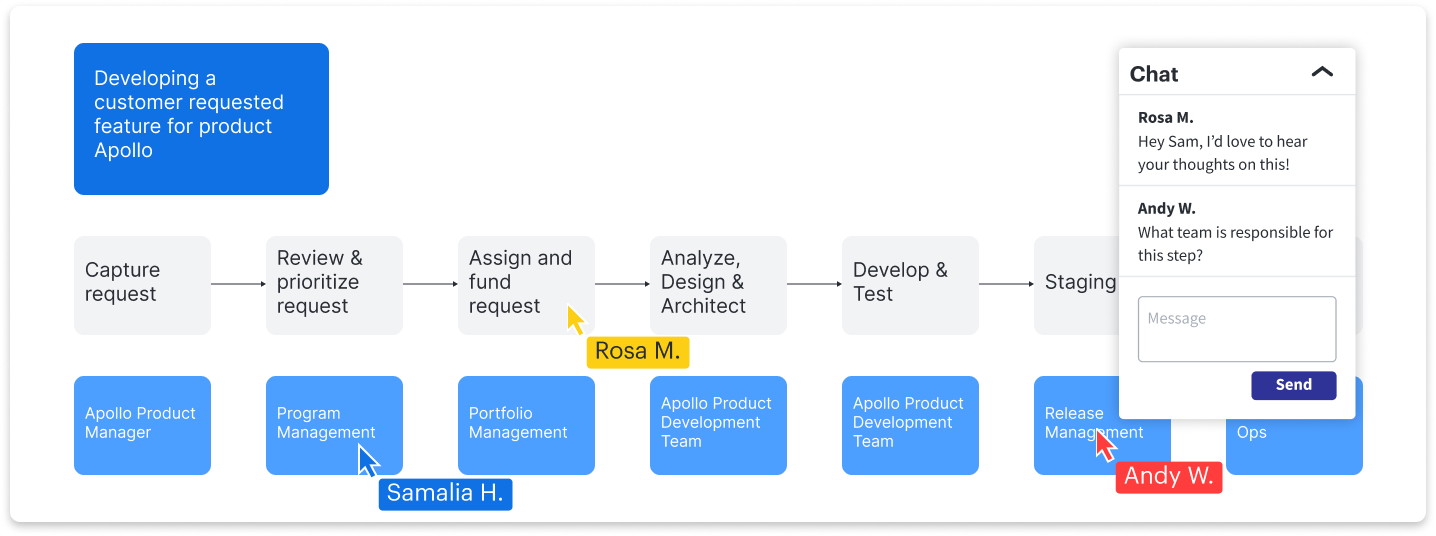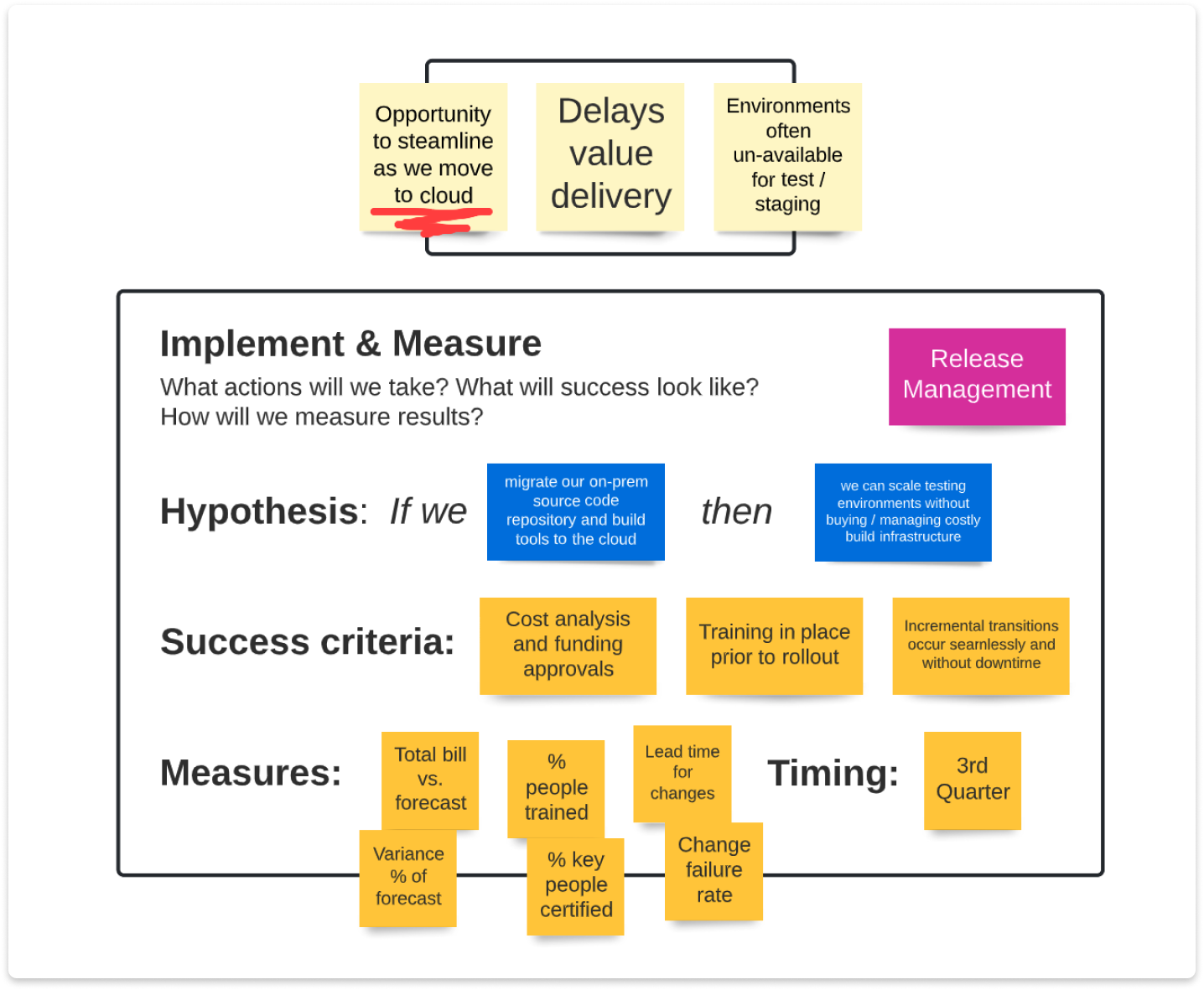This guide covers:
Traditional approaches to delivering products or services don't cut it in a fast-paced, competitive landscape. Many organizations have looked to Agile methodologies like Scrum and DevOps to increase their responsiveness and speed of delivery, but they have struggled to achieve the full outcomes promised by Agile.
A common factor that prevents many enterprises from reaching their agility goals is organizational silos. While using particular Agile frameworks can optimize processes and increase the agility of an individual team, value is rarely delivered within a single team—in fact, value is most commonly delivered across many, cross-functional teams. While some silos are necessary to maintain efficient, streamlined work, they can also impact communication between teams, making it difficult for the business to pivot as markets shift.
Organizations can bridge silos and enable the collaboration needed for continuous value delivery by understanding their value streams. Effective value stream management can help teams accelerate product delivery, exceed customer expectations, and support their business agility journey. As the 2021 Business Agility Report explains, “By focusing on understanding your value streams, design your organization and work processes to be customer-centric, minimizing handoffs between teams to maximize value creation.”
But what is value stream management? Where did it originate, how does it work, and how does it benefit an organization’s agile journey? Lucid's Jeff Rosenbaugh, Senior Director of Professional Services, answers these questions in this comprehensive guide.
What is value stream management?
To understand value stream management, it's important to define and delineate value streams, value stream mapping, and value stream management.
- A value stream is the sequence of activities a team or organization takes to deliver value to a customer or respond to a customer need.
- Value stream mapping is a process that determines, illustrates, analyzes, and improves the steps required to deliver a product or service to customers. A value stream map can also reveal delays, inefficiencies, and wasteful steps in any process—arguably the most important principle of the Lean philosophy.
- Value stream management is a systematic approach that focuses on increasing the flow of business value from customer request to customer value with the goal of shortening time-to-market, increasing throughput, improving product quality, and optimizing for business outcomes.
"Value stream management is that next step of engagement that looks at how to more effectively drive ongoing continuous improvement and drive more customer value," says Rosenbaugh.
Origin of value streams in Lean manufacturing
The adoption of manufacturing ideas and terms has seen a long transition to the software and product development space. The term “value stream” was born of the Lean manufacturing movement to describe the material and information flow to create value. For instance, a value stream can be activities or services that provide value customers are willing to pay for.
From the assembly line to lines of code
When you think of efficient production, you might think of the assembly line implemented at Henry Ford's auto factory at the turn of the 20th century. Considered "the father of Lean manufacturing," Ford drove himself and his company to create operational efficiencies and, as a result, better products. It's often said that Taiichi Ohno modeled and continued improving upon Toyota's praised manufacturing methods after Ford's Lean model.
What made the assembly line so successful was its emphasis on cutting out any part of the production that does not add value (known as “waste”). This production method resulted in a highly efficient, streamlined, and profitable manufacturing process, and its principles remain relevant for new means of production like software development.
An agile perspective
The pace of modern business requires an agile, adaptive outlook. Amid ongoing digital transformation, increasing business complexity, and now the adaptation to hybrid work, organizations must completely rethink the people, processes, and tools they need to keep pace and stay competitive. The result, particularly during times of crisis, has been accelerated innovation and adaptation—but also uncertainty, upheaval, dips in productivity and happiness, and burnout. Focusing on high-value, impactful work has never been more critical on the journey to business agility and larger-scale agile transformation.
In the eyes of seasoned agilists, a focus on value streams is imperative to bridge the gap between merely following Agile practices and realizing the true promise of agility. Through this lens, value streams relate to the ongoing shift of focusing on value vs. economies of scale or cost. In simpler terms, instead of prioritizing how many widgets or new features you can create per dollar spent, you prioritize what updates and developments will drive more value for the customer—and ultimately, the business. You can think of this as prioritizing outcomes instead of output.
Value streams help create a culture of continuous improvement and enable teams to respond more quickly to shifting customer requirements without disruptive reshufflings or slowdowns. The goal is to always deliver the most value to both customers and the business, as Rosenbaugh explains:
“Embracing the concept of value streams, aligning your organization to leverage them, and shifting from project to product-based funding models is what separates organizations who can truly be responsive to the market from those who struggle to simply react to it.”
Benefits of value stream management for business agility
It's said that a jack of all trades is also a master of none. And when it comes to business success and longevity, the quickest way to dilute the value you deliver to customers is to focus on too many things.
Value stream management helps leaders focus on the most important path and ways to continuously improve that system of delivery. This includes the identification of waste in the system and places where the flow may need to change for regulatory reasons or at the request of customers. Value stream management benefits organizations by:
Accelerating time to value: When you focus on improving the system and full value stream instead of driving functional efficiency in individual silos, you naturally accelerate time to value. In fact, simply bringing your organization on a journey of discovering and managing your value streams will help individuals and leaders more effectively tie the work they do to the end result.
The value steam mapping and management process empowers teams to quickly identify where waste occurs and focus on removing waste to increase efficiency. This is a virtuous cycle of continuous improvement that leads to less disruption and more value over time.
Aligning cross-functional teams: Value stream management helps teams stay aligned as they work toward a common goal or outcome. If teams agree that a workflow or task will have a net positive impact on the customer and the company's revenue, it's easy to deprioritize less critical tasks, eliminate duplicative work, and keep teams moving quickly toward the finish line, together. Value stream management can help you identify how to create a better flow around critical handoff points—and also reduce unnecessary handoffs that slow down time to value.
Clearly measuring system performance: With a clear understanding of an organization's value streams, the work of senior leadership can become more transparent—the flow of value, and the steps to get there, are defined and aligned against key performance indicators and more effectively measure system performance. This data can be used to inform strategic decisions, such as where to allocate resources or improvements to prioritize.
Making data-driven investments: When organizations map their value streams for the first time, they often discover that current budget allocations don’t properly support the end-to-end flow of value to customers. Instead of funding individual projects, allocate your budget to value streams. This strategy makes it easier to adapt to changing customer needs and supports self-organizing teams that are aligned on delivering maximum customer value.
When you have multiple value streams in your business, mapping and managing them may also serve as a mechanism for understanding where your investment dollars may be most effectively utilized. For example, if one value stream is highly effective and delivering well, you may favor it for investment (at least in the short term) over another stream that is working to eliminate significant waste and dependencies.
Eliminating waste and improving effectiveness: Value streams also help eliminate many different types of waste across any project lifecycle, including time spent on unnecessary work, handoffs, defects and delays, overproduction of extra features, in-project context-switching, and unnecessary post-project learning maps. Eliminating these sources of waste increases throughput and decreases overworked and overburdened teams.
Common pitfalls in value stream management
Once implemented, value streams can be part of an ongoing, continuous model of improvement and agile product development. Value stream management is a new way of thinking and working—not a "one-and-done" fix.
But like any new process, value streams can fall short if not embraced as part of a systematic effort to adjust and improve. There are a few reasons organizations might fail to embrace or implement value streams:
Upsetting the status quo: Change is regularly met with resistance—especially when you're concerned about what the change might reveal.
Building a value stream is an opportunity to identify misaligned priorities, uncover inefficiencies, and understand customer needs—a process that may upset a business's status quo and how leaders understand their business.
Discovering your existing value streams and embracing agility will do something many leaders consider to be inherently dangerous: It will shine a light on existing problems. Although it's intimidating (and potentially uncomfortable) to face the problems that value streams uncover, leaders with a growth mindset can embrace their discoveries with courage—and use the findings as fuel for continuous improvement.
Many older, more established, or heritage organizations lean towards justifications that business is too complex to be viewed through the lens of value streams. While this is untrue, it is understandable that the size and complexity of their organizations make it challenging to know where to start to build out value streams. Often, value stream mapping reveals that their products and services have grown too diverse and they may need to scale back.
Sophistication bias: It may take time to integrate value streams into your agile work processes, but many organizations overcomplicate it.
"Some leaders think it sounds so simple, and therefore it can't possibly work," says Rosenbaugh. "Because if it were that simple, we would have already done it."
This sophistication bias drives leaders toward expensive investments to solve what they deduce must be a very complex and challenging problem. In reality, value streams, value stream mapping, and value stream management are quite simple. Sticking to the fundamentals will help you understand what your business is doing and where you need to get more efficient.
Though value stream identification and management itself is simple, it often illuminates very complex challenges. The challenge comes in the resolution, not the identification, of the problem—whether it’s because the solution is actually challenging or stubbornness gets in the way of change.
Changing work environments: Of course, Lean and Agile methodologies were created within the framework of in-person work. The pandemic altered, perhaps indefinitely, where and how people work. Hybrid and remote teams are here to stay, so organizations must adapt to match these new workplace dynamics, including reevaluating the way value streams are mapped and managed.
To ensure the right team members are involved in the process and aligned on action items, it’s important to map your value streams in a digital, adaptable format. This will allow team members to collaborate, no matter where they’re working.
What to measure in value streams
Value stream thinking requires an unerring focus on the flow of value to the customer without compromising performance. And while there is increased pressure to bring products to market quickly and efficiently, the right metrics can help you stay focused on what matters most.
Once you've mapped out a value stream, there are a few ways to measure and optimize workflows:
Flow metrics indicate the rate of value delivery in relation to desired business outcomes. These metrics are calculated based on units of work that matter to the business, including features, defects, debt, and risk.
- Flow time: Also known as cycle time, flow time measures how quickly the work is complete so it can start to deliver value. This metric is critical in making project estimates, allocating resources, improving workflows, and increasing efficiency.
- Flow velocity (throughput): Measures the rate at which work is completed over a period of time. This metric helps identify conflicting priorities and improve customer satisfaction.
- Flow load: Measures the volume of in-progress work and demand within specific value streams. This metric helps manage resources and priorities and identify under- or overutilized value streams.
- Flow efficiency: Measures the amount of active work vs. wait time in a specific value stream. This metric helps identify roadblocks, increased costs, risks, and where workflows are taking up too much time.
- Flow distribution: Measures the ratio of the previous four flow metrics. This metric helps determine priority alignment and assess quality and productivity.
You can correlate these flow metrics against desired business outcomes, including value, cost, product quality, and customer satisfaction, and by doing so, you can connect the work done to the impact on the customer, the business, and revenue.

Managing your value streams is managing your business. Here’s how to use them.
Many organizations believe they're not mature enough for value stream management. That's an overcomplicated view. Teams can take simple steps based on where they are today to start building a culture of continuous improvement and increasing agility in their organization. Try out Lucidchart's value stream workshop template to follow along with the steps below.
Step 1: Get the right people in the room
Buy-in and strategic alignment are important parts of value stream management—and both require having the right people in the room to map out value streams, make decisions, and set priorities. Ideally, both leaders and practitioners should be a part of this process. Align with the leaders who own activities related to that product or service and get them committed to collaborating on the study and supporting improvements.
However, don't worry about having all the right people in the room right from the start. Part of value stream management is identifying inefficiencies, blindspots, roadblocks, and unknowns about your processes, meaning you may identify and need to loop in additional viewpoints and stakeholders as you embark on your value management journey. Rosenbaugh explains that the goal is progress, not perfection:
"Value stream mapping is a highly collaborative activity—and you may never have the exact right people in the room. It's about continuing the conversation and uncovering what you don't know. It takes time, but the payoff is worth it."
Step 2: Brainstorm your value streams
Identify the product or service you'd like to study and improve. Your organization will likely have multiple value streams, so work collaboratively to brainstorm as many as you can. These could include activities like “Billing a customer for services” or “Taking a new product to market.”

Step 3: Choose a value stream to map
Pick one value stream from your brainstorm to focus on and map out the primary steps that occur in the value stream as is. Understanding your as-is process, in all of its flaws and glory, is the reason you're doing this.
Avoid getting caught up in every little task—instead, focus on a level that makes sense to how you describe your business. Starting at a high level will make it easier to identify areas that are running smoothly and efficiently, as well as areas that could be improved.

Step 4: Identify who‘s in charge of what
On your map, record which individuals or teams are responsible for each step in order to help cross-functional teams understand their role and accountabilities in quickly delivering value.

Step 5: Start to track, analyze, and identify improvements
With your value stream fully mapped, you can start to analyze and track flow metrics. Use data to reflect on your value stream map to identify things you may not have noticed or anticipated before you started the value stream management process. Continue to identify wasteful moments in the process, long cycle times, or quality problems resulting in rework.
With the data you now have, it’s time to identify improvement opportunities. Ask the questions:
- What isn’t working currently?
- How could we reduce handoffs?
- How can we better coordinate cross-functionally?
Set your long-term goals and vision, and sketch out an ideal state value stream map illustrating goals for the items that lead to a leaner, more effective process. Align stakeholders and project leadership to this vision and continue to communicate, guide, and optimize the work.

Step 6: Continuously improve
Create and carry out a consistent, repeatable implementation plan to set yourself on the path to continuous improvement. Be specific with your action items to ensure follow-through. This means identifying who is responsible for implementing the change, when it will be implemented, and what success criteria and measurements you’ll use to gauge effectiveness.

It can be helpful, particularly for dispersed teams, to document your value streams and plans for improvement in a shared, virtual space. This ensures accountability and keeps all teams and stakeholders aligned on progress and iterations made throughout the ongoing value stream management process.
Tools to help in value stream management
Seeking to better understand business processes, many organizations have turned to value stream management software with the hope that it may provide deep insights into the state of their business. In reality, much of what these tools promise to uncover can be more clearly understood by simply pulling your people together to identify and map out your value streams.
“Most organizations already know where their waste is once they start visualizing processes,” says Rosenbaugh. “Leaders will already be overwhelmed by what they find through this process without having to invest in some of these sophisticated tools.”
Many of these tools can distract you from the fundamentals and the bread and butter of value stream management: value stream mapping.
Lucidchart's value stream mapping software is designed to help you visualize and optimize any process, better understand the flow of production and information, add value by eliminating waste and inefficiencies, collaborate and share your value stream across departments, and work with your existing workflows.
Closing tips
Start simple. Don’t get too caught up in building a polished value stream map when you start. This stage is all about learning, sharing information, and adapting. You can sketch an initial value stream by hand or use intelligent diagramming software to collaborate, align teams, and record the various iterations of your value streams.
Try mapping your value stream in reverse, from the end product or customer experience to its origins. Many veteran VSM practitioners work in reverse, as some points of friction can become more clear and meaningful from this perspective.
Don't be afraid of what you learn. Too many leaders shy away from the problems they uncover as they discover value streams. For example, you may realize your organizational design has introduced too many dependencies and handoffs. Rather than shy away from these uncomfortable realities, use this information to make incrementally better decisions going forward.
Embrace the journey. As you identify your value streams, go into it knowing that you will continue to learn and unpack more as you drive improvements and experiment with changes. This mindset is particularly important as you might look to reorganize around these value streams—you may want to test with "temporary teams'' before you completely reorganize.
Treat value stream maps like a living document. Be open to learning, making changes, and reviewing how each change impacts your value stream over time. Document the adaptations you make so it’s clear for you—and any other team members or stakeholders who need context—how the value streams have evolved and their current state. This approach will give you greater control in thinking systematically about your business and constantly improving.
Ask why. And keep asking why. Lean Six Sigma is also called the Five Whys. Continue to ask why something is done the way it is—and don't make assumptions. Continue this process until you arrive at the root cause of the problem or action.

Ready to map and manage value streams?
Accelerate time to value with skilled professional services experts to consult, train, and support you in identifying and managing your value streams in the Lucid Suite.
Get in touchAbout Lucid
Lucid Software is the leader in visual collaboration and work acceleration, helping teams see and build the future by turning ideas into reality. Its products include the Lucid Visual Collaboration Suite (Lucidchart and Lucidspark) and airfocus. The Lucid Visual Collaboration Suite, combined with powerful accelerators for business agility, cloud, and process transformation, empowers organizations to streamline work, foster alignment, and drive business transformation at scale. airfocus, an AI-powered product management and roadmapping platform, extends these capabilities by helping teams prioritize work, define product strategy, and align execution with business goals. The most used work acceleration platform by the Fortune 500, Lucid's solutions are trusted by more than 100 million users across enterprises worldwide, including Google, GE, and NBC Universal. Lucid partners with leaders such as Google, Atlassian, and Microsoft, and has received numerous awards for its products, growth, and workplace culture.

